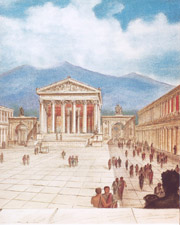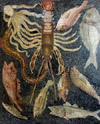
HISTORICAL SURVEY
It is difficult to say just how large any protohistoric settlement on the ridge of lava where Pompeii was to rise may have been. Not enough has been found in the way of pottery that can be referred to the inhumation culture of the Iron age pit tombs (a fossa, IX VII cent. B. C), but in any case the lack of water here makes it unlikely that an inhabited centre of any size existed before the middle of the 7th cent. B. C.
In the course of the VIII cent. B. C. Greek (Ischia and Cumae) and Etruscan colonization (Capua) in the territory of Campania stimulated the development of Pompeii as a city around the area of the Forum. A point of encounter for important trade routes, it became a clearing station for traffic towards the hinterland. Up until about the middle of the V cent. B. C. the city was dominated politically by the Etruscans, whose presence is verified by the finds of bucchero with Etruscan inscriptions. In the course of the VI cent. B. C. the influence of the Greek culture is also documented by the terracotta parts which decorated the Temple of Apollo, by important ceramics and architectural elements that were part of the so called Doric Temple. During the V cent. B.C., after the defeat of the Etruscans by the Greeks of Cumae and the Syracusans in the battle of Cumae in 474 b.C., the entire fertile Campanian countryside was occupied by Samnite peoples from the mountain hinterlands, both as a result of military operations and through a slow gradual penetration and assimilation with the local population. This was probably when Pompeii spread out over the entire lava ridge and was surrounded by walls.
It was in the IV cent. B. C. that Pompeii began its great urban expansion along a grid layout, and the buildings began to be constructed in limestone. A new series of conflicts broke out in that same century between the Samnites who had become city dwellers and new waves of Samnite peoples from the mountains. The intervention of Rome played a determining role and at the end of these struggles, known as Samnite wars (343 290 B. C.), Rome dominated all of Campania. The part played by Pompeii was minor, both here and in the war with Hannibal (218-201 B. C.). In fact, while victorious Rome subjected most of the Campanian cities which had sided with Hannibal to heavy sanctions and deprived them of their liberty, the position of Pompeii was not particularly unfavourable. To the contrary, with the dominion of Rome over the Mediterranean, merchandise moved more freely and in the course of the II cent. B.C. the city’s economic growth accelerated, particularly with the production and exportation of wine and oil. This state of well being was reflected in the spurt in public and private building: in this period the Temple of Jupiter and the Basilica were built in the area of the Forum, which, together with the Triangular Forum, was restructured, while in the field of private undertakings a patrician dwelling such as the House of the Faun competes both in size and magnificence with the dynastic palaces of the Hellenistic East. Pompeii sided with the Italic allies in the battle for the right to Roman citizenship which led to the Social Wars (90 89 B. C.).
In 89 B. C. the city was besieged by Sulla and conquered without particular consequences. It was transformed into a municipium and governed by the magistrature of the quattuorviri between 89 and 80 B. C., when it was turned into a military colony named Cornelia Veneria Pompeianorum by Publius Cornelius Sulla, nephew of the dictator. This was when the ordo decurionum, or local senate was formed, through the admission of pro Sullan elements to whom the principal magistrates were also entrusted. Economically the city continued to flourish and new important public buildings, such as the Amphitheatre and the Odeion. were created.
The Imperial period opened with the entrance into Pompeii of new families favourable to Augustus and a whole hearted adhesion to the new political ideology manifested in a propagandistic public building program, such as the Building of Eumachia and the Temple of the Fortuna Augusta. After an obscure period of political crises under Claudius, the situation was fully normalized under Nero. It was under his reign, in A.D. 59, that the bloody riots in the Amphitheatre between Pompeians and Nucerians took place. In A.D. 62 a disastrous earthquake heavily damaged the buildings in the city. The following years were dedicated to the challenging job of rebuilding, which was still in progress when Pompeii was completely buried under a dense hail of volcanic cinders and ash in the fatal eruption of Vesuvius on August 24, 79 A.D. A moving eyewitness account of the tragedy has been left us in two letters sent to Tacitus by Pliny the Younger.






